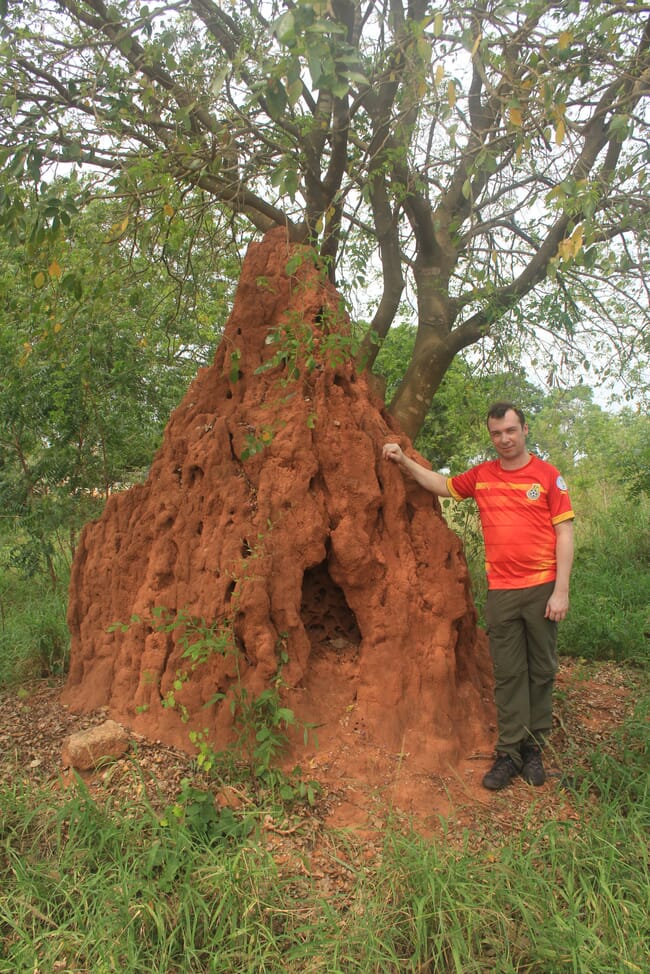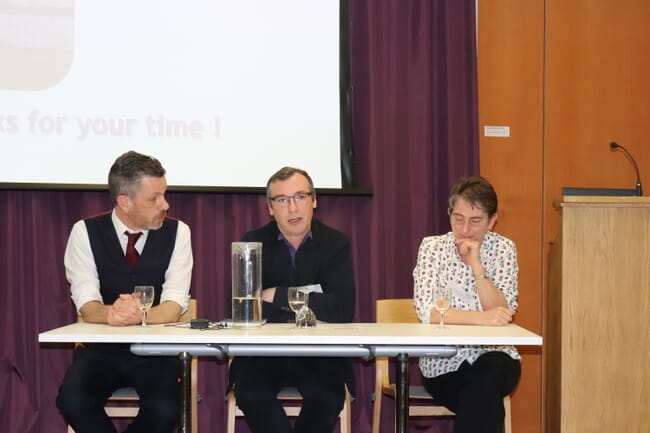What inspired you to look into combining insect farming with aquaculture?
I took my BSc and MSc at Stirling’ Institute of Aquaculture and first became interested in farming insects about 10 years ago, because of its potential for waste mitigation. It came from my experience of working on fish farms – I’d been responsible for getting rid of some of the mortalities, which was a pretty disgusting job. I started reading around the issue and decided to do my PhD research on better ways to use the mortalities other than incinerating them or putting them into landfill.

When conducting a literature review I came across the work of Paul Olivier, in Vietnam, who had invented something called a biopod – you put your waste in, wait for black soldier fly to lay their eggs in the substrate and then they grow, as larvae, inside the structure.
No one was farming black soldier fly (BSF) commercially at the time – my PhD colleagues pretty much laughed at my idea. They also said that there were lots of issues with using insect proteins. People had been doing it in various forms for years – such as hanging rotting carcasses over ponds so that maggots fall off them and help feed the fish.
However, as my PhD progressed, the interest in the use of BSF was really taking off, and this coincided with the launch of projects such as the EU-funded PROteINSECT. And, after finishing my PhD, I joined the Ento-Prise project, which tried to produce BSF larvae, grown on local food waste, for feed for the aquaculture and poultry sectors in Ghana. Getting hold of substrates proved difficult, however – manure was in demand for fertiliser, for example, and vegetable waste used for goat feed. Substrates were also often contaminated with chemical waste from things like discarded batteries.
Soon after that I managed to secure some funding from companies looking for better ways to utilise salmon mortalities. We produced insulated versions of the biopods which we stocked with larvae and took to a farm on the west coast. I started out with 100 larvae which I bought from a pet shop – they’re sold as live food for lizards – and grew them in my house initially. My business plan was to sell the larvae produced from the project as live food for reptiles – the regulations aren’t so strict, as they’re not going into the human food chain and the mark-up is huge. One hundred live larvae (about 10g in total weight) sell for about £4 – [ie about £400,000 per tonne].
What happened?
We showed that the larvae got through the morts very quickly and the larvae grew well too. What little was left of the morts was incinerated and I was able to give the larvae to the pet shop to feed the lizards, which liked them very much. However, the main problem was trying to get the farmers to manage the project – they didn’t have the time, training or experience to look after the larvae.
Many of the current crop of insect producers seem to focus more on protein production rather than waste reduction. Why is that?
Probably because of the pressure [from the media and NGOs, for example] to come up with sustainable substitutes for fishmeal, which is limited in supply. Soy, [which has replaced much of the protein content formerly provided by fishmeal], after all, is connected to environmental damage, deforestation and soil erosion.

Do you think they can compete with the global commodities that make up the bulk of fish feeds at the moment?
I think at the moment – in Europe anyway – they will struggle, due to issues with legislation and logistics. While you can feed larvae on a waste product, they’ll grow and you’ll get reasonable protein from them, they’re being fed on substrates that could be used directly to feed other livestock animals. Category 2 by-products – like catering waste, manure and domestic waste – can’t currently be used in farmed animal feeds and larvae are themselves treated as farmed animals in the legislation.
They will also struggle to compete in terms of price. Feed producers are likely to offer them a similar price per tonne as soy protein concentrate (around £350 per tonne) as opposed to fishmeal (around £1,500 per tonne).
What sectors does the fly farming industry have to compete with for approved substrates?
Approved substrates, such as brewery and distillery waste, are currently largely used in poultry feed, but also in salmon feed too. And there’s no point in feeding such substrates to larvae first, as about 12.5 percent of the carbon and about 50 percent of the nitrogen is carried through from the substrate to the larvae – why lose such a high proportion of your nutrients feeding the larvae, when you could feed them directly to livestock?
Do you think pet food is a better sector to target than commercial aquaculture feeds?
It’s a strategy that seems to be working for a number of insect producers, such as Protix, as it means they can use grade 2 waste as a substrate, which is cheaper, as well as charge a premium for their product, as it can be marketed as sustainable and ethical, but Protix has ambitions to supply livestock and aquaculture feeds too.

If legislation changed would that alter the situation in Europe?
Perhaps, but the other problem is trying to produce something the formulators want – namely a consistent quality and quantity of supply. To formulate the diets correctly, the raw materials have to be the same every batch. But if you feed your insects on different waste streams, their nutritional properties will be inherently inconsistent.
There are, perhaps, ways around that, you could separate your wastes, but when the larvae grow they don’t maintain the exact same nutritional quality. Their protein changes into chitin as they get towards pupation. They also convert some lipids into saturated lipids, or fatty acids. So consistency could be an issue.
Commercial production of black soldier fly is still in its infancy, however, and people will probably work on producing a much more consistent supply.
And what do you think about using insects primarily as a means to reduce waste?
In 2015 I visited China as part of a fact-finding study on insect farming. They previously fed municipal catering waste and household food waste to pigs, but new legislation banned pig farming within the cities, which led to a waste problem. They tried to solve this by establishing a number of insect farms in and around cities and we visited a number of black soldier fly start-ups in Shenzhen, which seemed to be a good application for insect farms.
What do you see as the best application for insect farming in the long run?
I think insect farmers should target certain wastes that have no other use, although more research is needed on aspects such as the biosecurity angle. There’s a lot of manure, coming from industrial farming, that larvae could use, but you have to be careful with things like antibiotic contaminants. Larvae are also excellent at breaking down things like spoiled food and also food waste that has physical contamination – they will eat around objects like plastics or glass and then you can harvest those larvae.
But then the problem comes with the quality of the larvae – its inconsistency would make it suitable only as a supplementary feed for use in traditional extensive production systems, generally in the developing world, which are struggling to get good-quality feed resources in.
Would you focus on the developing world?
I think that – without a consistent substrate – it’s best suited to any application other than industrial production, which requires precise, formulated diets. If, however, you have a consistent source of manure and can produce consistent larvae with that manure, and harvest it at the right time, and you’ve done all of the science to make sure that it’s safe, then I don’t see why that couldn’t be used and formulated.
Would you say that insect farming is going to take off regardless, but it might not be a mainstay of the aquafeed industry?
I think it’s difficult to say, but the fish which are being produced with feeds containing insects at the moment are quite niche – and will perhaps be produced for a premium.
However, in countries where the legislation isn’t as strict, it may be possible to use cheaper substrates to produce insects cheaply and consistently. My gut feeling is that it is going to have a lot more mileage in the developing world at the moment for this reason. But, if producers in developing countries manage to cut down their costs and improve production, perhaps in the long term they’ll be able to supply insect meal to aquafeed producers in the developed world too.

